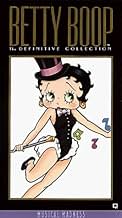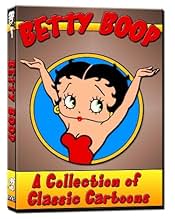CALIFICACIÓN DE IMDb
6.9/10
872
TU CALIFICACIÓN
Agrega una trama en tu idiomaIn her only color cartoon, Betty Boop goes to the ball thanks to her fairy godmother; later, only her foot fits the glass slipper.In her only color cartoon, Betty Boop goes to the ball thanks to her fairy godmother; later, only her foot fits the glass slipper.In her only color cartoon, Betty Boop goes to the ball thanks to her fairy godmother; later, only her foot fits the glass slipper.
- Dirección
- Guionista
- Elenco
Jack Mercer
- Various
- (voz)
- (sin créditos)
William Pennell
- Pumpkin
- (sin créditos)
Bonnie Poe
- Betty Boop
- (voz)
- (sin créditos)
- …
- Dirección
- Guionista
- Todo el elenco y el equipo
- Producción, taquilla y más en IMDbPro
Opiniones destacadas
This is the only color cartoon we have of the delicious Miss Boop, incidentally made on the cusp of when the Hayes Code was enforced. So we have her at her bouncing sexist. And we discover that she is a redhead!
Pretty much all the material that Disney later covered in his feature cartoons had been done in a Boop version first, and with more energy. I think if Fleischer had arranged the backing to make feature cartoons, we'd now be visiting BoopLand in California, Florida and Paris.
Oh, there's another unique thing here. Betty does her trademarked butt dancing but when with her prince at the ball, has an equally sexy smooth ballroom dance. I think it is the only non-jazzy dance in all the Boop cartoons.
Ted's Evaluation -- 3 of 3: Worth watching.
Pretty much all the material that Disney later covered in his feature cartoons had been done in a Boop version first, and with more energy. I think if Fleischer had arranged the backing to make feature cartoons, we'd now be visiting BoopLand in California, Florida and Paris.
Oh, there's another unique thing here. Betty does her trademarked butt dancing but when with her prince at the ball, has an equally sexy smooth ballroom dance. I think it is the only non-jazzy dance in all the Boop cartoons.
Ted's Evaluation -- 3 of 3: Worth watching.
This is the first color film from the Fleischer Studio and it's in something called "Cinecolor"--which appears to be a variation on 2-color Technicolor. Unlike the older 2-color Technicolor, the film seems to have a lot of blues and a slightly greater color spectrum. It is easier on the eyes than the older process but it truly isn't full color--the full spectrum is missing. This cannot be confused with the rich and vibrant colors of true Technicolor--a more expensive process that was also being introduced around the same time. Not surprisingly, Technicolor became the dominant color process, as it simply looked nicer and wasn't mostly orange. Now despite these limitations, this Betty Boop cartoon is nice to look at because like many of the Fleischer cartoons, there were very lovely line drawings and a nice 3-D look to the backgrounds (something this studio specialized in). These help you overlook the orange hue on most everything.
Clearly this in an innovative film, though I also think it suffers from two major problems. First, although it's a Betty Boop cartoon, it's an amazingly "by the book" rendition of the old story. There isn't much new or exciting to the tale. Second, if you are not a fan of Boop, you also might not be all that impressed--simply because she's a rather dull character compared to animated characters from the 40s and 50s (which had a lot more personality). However, compared to competing contemporary cartoons of the era, this is a fairly good short. While nowhere near the quality of most Disney cartoons, compared to Warner Brothers and the other studios, it is clearly technically superior. Worth a look if you are a film historian or want to see a better than average cartoon of the 1930s.
By the way, I saw this film on the DVD entitled "Cartoon Crazys: And The Envelope Please". This is a rather poor compilation of supposedly award winning and nominated films. Poor because several of the films are very lame and are NOT award nominated, the prints are rather bad and parts of some of the cartoons are missing! This might account for the extreme redness of the cartoon, as it could use a good restoration. Cinecolor and Two-Color Technicolor films often get an even more orange look over time but clean up quite beautifully.
Clearly this in an innovative film, though I also think it suffers from two major problems. First, although it's a Betty Boop cartoon, it's an amazingly "by the book" rendition of the old story. There isn't much new or exciting to the tale. Second, if you are not a fan of Boop, you also might not be all that impressed--simply because she's a rather dull character compared to animated characters from the 40s and 50s (which had a lot more personality). However, compared to competing contemporary cartoons of the era, this is a fairly good short. While nowhere near the quality of most Disney cartoons, compared to Warner Brothers and the other studios, it is clearly technically superior. Worth a look if you are a film historian or want to see a better than average cartoon of the 1930s.
By the way, I saw this film on the DVD entitled "Cartoon Crazys: And The Envelope Please". This is a rather poor compilation of supposedly award winning and nominated films. Poor because several of the films are very lame and are NOT award nominated, the prints are rather bad and parts of some of the cartoons are missing! This might account for the extreme redness of the cartoon, as it could use a good restoration. Cinecolor and Two-Color Technicolor films often get an even more orange look over time but clean up quite beautifully.
This is one of my favorite Betty Boop cartoons, and "Cinderella" is one of my favorite fairy tales, even though I'm an adult. I want to emphasize that this was just sixteen years ago, prior to Disney releasing their animated theatrical version.
Like I said, I love animation from Fleischer Studios, as well as animation from Disney, Hanna/Barbera, Rankin/Bass, and Studio Ghibli from Japan. Betty Boop is one of my favorite cartoon characters, as are Bugs Bunny, Tweety, Pepe le Pew from Warner Bros., and Disney's Donald Duck and Mickey Mouse. I love the ballroom scene where Betty/Cinderella and the Prince dance-until midnight, that is.
I love the song in this cartoon featuring Betty Boop, despite it being in two-strip Cinecolor.
Like I said, I love animation from Fleischer Studios, as well as animation from Disney, Hanna/Barbera, Rankin/Bass, and Studio Ghibli from Japan. Betty Boop is one of my favorite cartoon characters, as are Bugs Bunny, Tweety, Pepe le Pew from Warner Bros., and Disney's Donald Duck and Mickey Mouse. I love the ballroom scene where Betty/Cinderella and the Prince dance-until midnight, that is.
I love the song in this cartoon featuring Betty Boop, despite it being in two-strip Cinecolor.
Long before Rodgers and Hammerstein had the idea of musicalizing Cinderella, Betty Boop made the midnight pumpkin change tunefully, with verve, sex and good story editing. The plot is trimmed to its essentials, the splendid backgrounds may have influenced the Disney Beauty and the Beast, and the closing shot of the Pinocchio-nosed sisters wraps everything up with a laugh.
Betty Boop as Cinderella. an idea who seems strange but this short animation is the ideal proof for define it as inspired. because all is nice - the songs, the dance, the short story preserving essence of fairy tale and the colors, the technique and the ingenuity of Betty. at first, naive, it is the perfect illustration of significant episode of animation history.
¿Sabías que…?
- TriviaRather than making animated backgrounds using drawings the Fleischers pioneered the idea of using either models or cutouts mounted on a turntable. The table was slowly spun and photographed. The foreground animation was then placed in front of the photographed backgrounds. This not only saved hundred of hours of drawing but also lent a 3D effect to the back ground. It was used here and in numerous "Popeye" cartoons.
- Versiones alternativasOne 1980s VHS release of "Poor Cinderella" has the entire color cartoon presented in black-and-white.
- ConexionesEdited into Betty Boop Confidential (1995)
- Bandas sonorasPoor Cinderella
Written by Charles Tobias, Murray Mencher, Jack Scholl
Sung by Betty Boop
Performed by Phil Spitalny and his orchestra
Later sung by Betty and by the singer with the megaphone
Selecciones populares
Inicia sesión para calificar y agrega a la lista de videos para obtener recomendaciones personalizadas
Detalles
- Tiempo de ejecución
- 11min
- Relación de aspecto
- 1.37 : 1
Contribuir a esta página
Sugiere una edición o agrega el contenido que falta

















